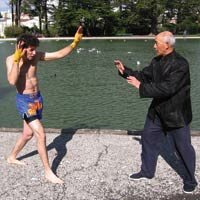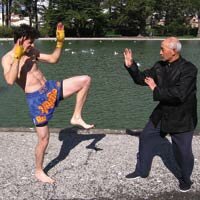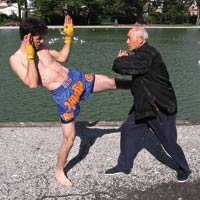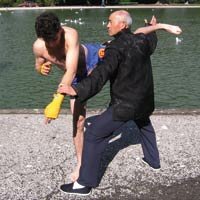
The Root of All Power
Daniel I. Rauch
 Studying the classical techniques and principles of bagua is valuable for martial artists and students of sportfighting. Bagua’s circular footwork patterns and blocks and parries help easy repositioning so opponents are consistently off balance and susceptible.
Studying the classical techniques and principles of bagua is valuable for martial artists and students of sportfighting. Bagua’s circular footwork patterns and blocks and parries help easy repositioning so opponents are consistently off balance and susceptible.
At bagua’s core is a focus on the simultaneous movement and awareness of the inner body, as well as a changing of directions referred to as a palm change. Moving all parts in unison and focusing on the lower and inner body integrates the mind and produces internal power. Done correctly, the end result should feel intense, relaxed and effortless.
Bagua’s unity of motion is in sharp contrast to other martial training methodologies, including wing chun, karate and tae kwon do. In these arts, the feet often remain stationary while the upper body attacks, potentially leaving one frozen against a more skilled opponent who is versed in timing, movement, distancing and rhythm. Bagua is an effective bridge here; by focusing heavily on footwork training the upper body is open to relax while being in an ideal position to strike.
Power of the Technique
Bagua was created in the mid-19th century by Dong Hai Chuan, who synthesized shaolin kung-fu, a Buddhist temple art, with Taoist energy practices, which he learned from martial monks in the hills of rural China. Bagua is considered one of the three major “internal” martial arts. The palm or zhang is a primary weapon, and the constant changing of directions represents the addition of more opponents. Perhaps no other martial art seamlessly integrates history, philosophy and traditional cultural perspectives so literally into the power of their techniques as bagua. The Book of Changes and the eight trigrams inform and create all phenomena according to Taoist thinking, and the techniques behind the martial art of bagua do not merely employ a metaphoric usage of these principles.
Heavy emphasis on footwork is found in numerous experienced fighters who rely on footwork training to achieve whole-body power. These fighters will position themselves appropriately and strike a less-experienced fighter whose feet are crossed. Using multi-directional large and small circular footwork patterns in relation to the opponent, bagua helps one expose the vulnerable center of an opponent and take his balance through grounded non-linear movements.
Unlike aikido and other movement-based arts, the aim of bagua is not simply to move gracefully from harm and peacefully subdue the opponent. Instead, bagua’s agile movement centers on leading opponents into fatal strikes, reflecting its history as a lethal self-protection and combat science.
As with other internal martial arts, it is essential that the body of a bagua practitioner remains loose. The quality of stable, yet empty relaxation and how one reacts to force are as much a part of the art as its movements, postures and alignments. By engaging in slow, relaxed and controlled training the brain’s neuropathways adapt to learning smooth, fluid movements while staying energetically and physically balanced. As such, alignment and relaxed connected power become so integral that when sped up they become automatic. Ironically, this slow relaxation aids in the development of speed by helping the body function appropriately while under attack without the interference of the conscious mind. This doesn’t mean you react reflexively or mindlessly, but rather that the body efficiently transfers and redirects force based on its conditioning, and without needing a conscious command moves effortlessly from the lower back.
Total Confusion
In combat, bagua’s use of soft blocks and re-positioning disassociates and confuses opponents, giving them little frame of reference, because it seeks never to meet force head on. An opponent is misled into counterstrikes where power is increased savagely by the angle of their delivery. Training in constant repositioning and angling, while at the same time keeping the “ischial tuberosities” (or sits bones as they are called in yoga) pressing down, and the footwork light and agile and movement initiating from the lower back can focus each blow into a whole body strike.
The training methodology of bagua increases defensive prowess as well as striking power. Good fighters need to tirelessly train footwork patterns to create balance, flow and harmony within the chaos of a fight. In mastering one’s body positioning relative to an oncoming opponent, one can control an opponent’s aggressive actions and movement without force.
Bagua emphasizes staying rooted by effortlessly sliding your feet across the ground without lifting any part of the foot. Several traditional movement-based Japanese arts, including aikido, jiu-jitsu and ninjitsu, are similar in training the foot to connect to as much surface during movements as possible. Fighters from these disciplines will seldom lift their heel while rotating like a kickboxer; you will never see a classical internal martial artist rhythmically bouncing on the balls of their feet like a TKD stylist or bobbing and weaving and giving up their height like an aggressive sport fighter.
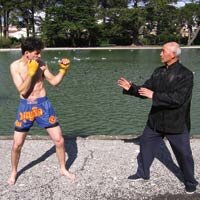 The author prepares to throw a jab/rear elbow combination at Xu.
The author prepares to throw a jab/rear elbow combination at Xu.
|
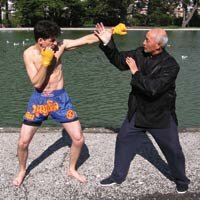 Xu blocks the elbow.
Xu blocks the elbow.
|
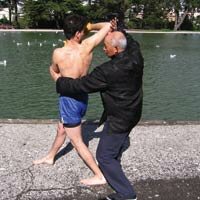 He flows with the rotation.
He flows with the rotation.
|
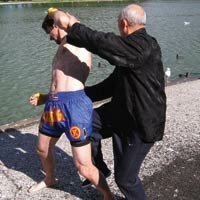 And finally executes a strike to the base of the spine.
And finally executes a strike to the base of the spine.
|
Sink Your Weight
In approaching bagua for the first time, one must relax and sink one’s weight in his feet, performing stepping movements without tension or distraction. It is here that true power can begin.
“The eyes must be focused, the intention and qi (chi) must lead the movements and above all the body must relax and be soft, loose, and open,” explains sifu George Xu, who learned bagua in China over 30 years ago. Xu is also a high-level hsing-I, Chen tai chi and larn sou master who teaches form applications as well as the essence of deadly internal power adds, “Without this calm soft feeling of emptiness, one cannot achieve the deep relaxed heaviness that is the internal ground force of bagua.”
The focus on freeing oneself of tension and returning to a natural state lets one find the true power of the bagua postures. The daily practice of circle walking also allows one to feel subtle force channeled through the body. A bagua master can redirect this force without external movement while also using it to move and support the body, which allows it to absorb strikes and deliver full-body blows. Unlike muscular force, which requires adrenaline to achieve striking tension, the internal martial artist harnesses power from relaxation, centering and natural body weight. Muscular force is ultimately limited as it relies on tightening the body and combining it with a swinging momentum to achieve a linear power. Since this relies on leverage, when confronted by greater leverage or a denser force it will likely lose.
A bagua strike comes from relaxation, allowing a bagua master confronted by a highly skilled martial artist with strong leverage to borrow and redirect the oncoming power. Power is channeled in multiple directions and not just along a linear path. This gives strikes the ability to penetrate. This occurs automatically at the point of impact as a function of the relaxed, yet stable quality of musculature instead of through technique or conscious effort. This sophisticated relationship between body and mind, bridged by a relaxed and enhanced flow of signals through the nervous system, is a bagua staple. Using less force also allows deep core muscles to relax into instinctively performing functions that were otherwise performed by more superficial muscle groups.
Xu emphasizes that the focus on softness in bagua “doesn’t mean that one is soft like tofu. There is still structure in the fluid balanced connected state and force hidden deep within the dan tien. Being perfectly balanced and having internal weight comes from the body’s center and core and can only be attained and felt through practicing sensations of lightness and emptiness in the limbs, otherwise one is merely using muscular force which is linear.”
This practice of emptiness and getting power from the ground by sinking the weight of the hips is combined with a bagua fighter’s ability to enter or retreat in conflict using advantageous angles instead of merely relying on simple linear movements. The mastery and fluidity of foot movement emphasized in the art allows a bagua fighter to subtly present part of his body as a target. Once the other fighter has committed to a strike aimed at vulnerability, the bagua artist changes direction and places the opponent off balance, leaving him open for a well-placed internal counterstrike.
It is essential to emphasize, however, that bagua is not merely a series of postures or techniques. Numerous profound spiritual and cultural principles lie at the core of its physical power. These Taoist principles and the living energy known as chi are at the core of bagua and reflected in the I-Ching (The Book of Changes), which traditional Chinese Taoist thinking credits as the root of all existence.
Any martial artist who spars regularly and wishes to attain mastery regardless of his discipline or style can benefit from the training methodologies and theories of bagua. Slowing down one’s movements in training to achieve a relaxed comfort in footwork, working on defensive angling, and tirelessly overtraining positioning to where full-body motion is one’s greatest asset in a fight, are several reasons why bagua fighters have proven themselves throughout the profound history of this unique and intelligent art.
Daniel Rauch is a Northern California-based martial artist and freelance writer. He last wrote, “Bagua’s Original Octagon” in the May issue.
Източник: www.insidekung-fu.com/content/view/75/0/

2. Най-големият български портал за бойни изкуства
3. Кунг-фу майстор на 116 г.
4. Световната конспирация срещу здравето
5. проф. Григорий Климов
6. Непознатата история
7. Любим линк
8. Любим линк
9. Двери на Православието
10. Пръст сложен където трябва!
11. Фондацията на д-р Матиас Рат
12. Исторически изследвания; история на България
13. Школа "Златен Дракон"; Кунг-Фу, традиционни бойни изкуства
14. "Онгъл" патриотична неформална организация
15. "Древна България" историческа група
16. "Големите 5 лъжи..." историческа група
17. Българска федерация по Кунг-Фу и Тай-Чи
18. Школа "Златен Дракон" /втори сайт/


